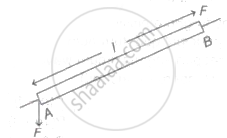Advertisements
Advertisements
Question
Answer the following question.
While rotating an object or while opening a door or a water tap we apply a force or forces. Under which conditions is this process easy for us? Why? Define the vector quantity concerned. How does it differ for a single force and for two opposite forces with different lines of action?
Solution
- Opening a door can be done with ease if the force applied is:
a. proportional to the mass of the object
b. far away from the axis of rotation and the direction of force is perpendicular to the line joining the axis of rotation with the point of application of force. - This is because, the rotational ability of a force depends not only upon the magnitude and direction of the force but also on the point where the force acts with respect to the axis of rotation.
- Rotating an object like a water tap can be done with ease if the two forces are equal in magnitude but opposite in direction are applied along different lines of action.
- The ability of a force to produce rotational motion is measured by its turning effect called ‘moment of force’ or ‘torque’.
- However, a moment of couple or rotational effect of a couple is also called torque.
- For differences in the two vector quantities.
- Moment of a force:
- Moment of a force is given as, `vectau = vec"r" xx vec"F"`
- It depends upon the axis of rotation and the point of application of the force.
- It can produce translational acceleration also, if the axis of rotation is not fixed or if friction is not enough.
- Its rotational effect can be balanced by a proper single force or by a proper couple.
- Moment of a couple
- Moment of a couple is given as, `vectau = vec"r"_12 xx vec"F"_1 = vec"r"_21 xx vec"F"_2`.
- It depends only upon the two forces, i.e., it is independent of the axis of rotation or the points of application of forces.
- Does not produce any translational acceleration, but produces only rotational or angular acceleration.
- Its rotational effect can be balanced only by another couple of equal and opposite torque.
APPEARS IN
RELATED QUESTIONS
Answer the following question.
Why is the moment of a couple independent of the axis of rotation even if the axis is fixed?
The moment of the couple is independent of ______
A mass of 20 kg is suspended from a rope wound on a wheel of diameter 80 cm. The torque about the axis of rotation is ______.
A rod I m long is acted upon by a couple as shown in the figure. The moment of couple is τ Nm. If the force at each end of the rod, then magnitude of each force is ______.
(sin 30° = cos 60° = 0.5)

